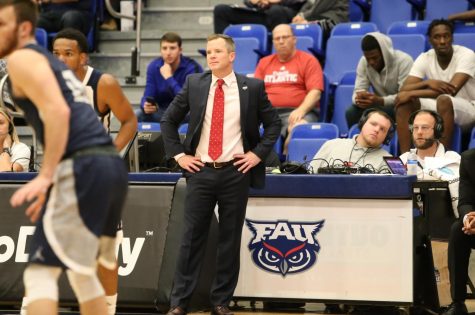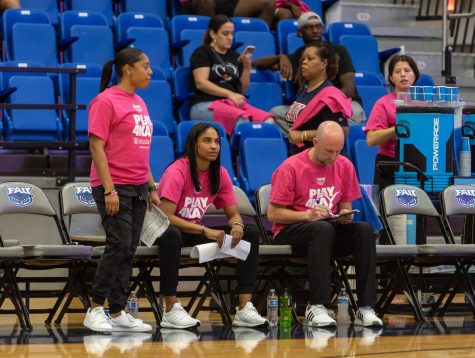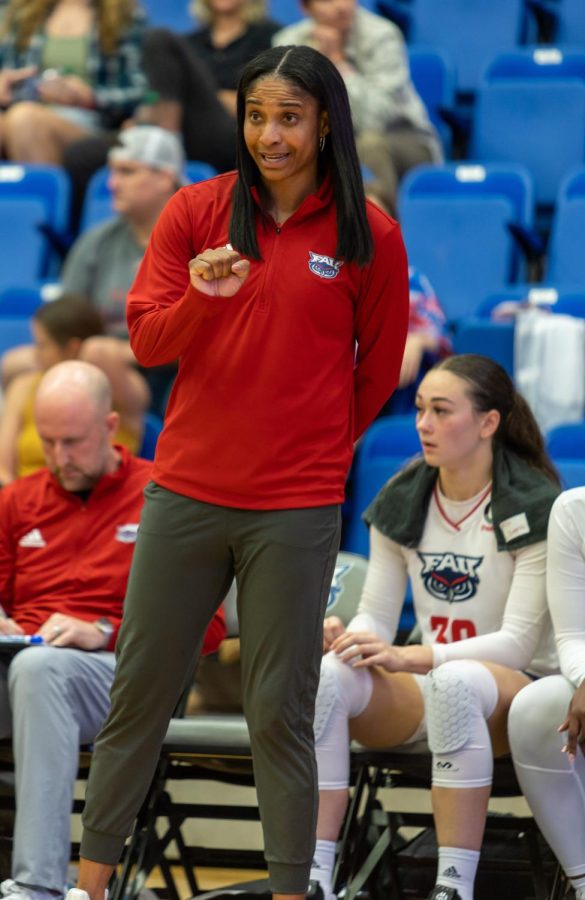‘Look good, play good’: How fashion and sports intertwine
Jennifer Sullivan pictured coaching in a red quarter zip sweater.
March 30, 2023
Clothing is more than what meets the eye. It isn’t just pieces of fabric put together to create an outfit. Instead, fashion reveals a more resounding message on how people think, feel, and operate in society. Arguably, one could say that the clothing someone wears attributes an idea as to who that person is.
“The arrangement and colors of fabrics allows people to categorize themselves based on their personality,” said Kyler Dixon, head stylist at Florida Atlantic University’s Fashion Forward.
You don’t need to be a fashion icon to wear clothes that make a statement. If the clothing one wears is authentic to their creativity and expression, then anything worn goes.
It may seem like fashion and sports do not coincide, but each has a direct influence on the other. In terms of expression, while athletes get to express themselves through their game, clothing allows them another avenue to “ball out.”
Many people pay attention to how professionals choose to carry themselves and it can influence their career.
Dating back to even the 1990s, sports and fashion became intertwined as athletes and coaches tried to build their brand and express themselves through it.
During his time as head coach of the NBA’s Los Angeles Lakers, Pat Riley, now team president of the Miami Heat, became known for his preference of suits during games. Riley would often be seen on the Lakers’ bench calling plays while sporting $1,000 Giorgio Armani suits.
Deion Sanders, NFL Hall of Famer, now head football coach at the University of Colorado, was known for his personal style, as much as his unmatched playing ability, throughout his entire career.
The photo of Sanders taking a phone call during the 1994 NFL Draft, donning a nylon tracksuit and black sunglasses, covered in gold chains, became as synonymous with Sanders as his nickname “Prime Time.” He was obsessed with his style on and off the field, and is credited with the quote, “If you look good, you feel good. If you feel good, you play good. If you play good, they pay good.”
In the same way each sport has continued to grow and evolve since then, the relevance of personal style in sports has continued to grow as well.
Recently, “tunnel outfits” have become a very popular, and widely discussed aspect of games across several sports. TNT’s semi-weekly broadcast, Inside the NBA, that features Hall of Famers Shaquille O’Neal and Charles Barkley, has a segment dedicated solely to showcasing athlete’s tunnel outfits. Across social media, there are countless pages dedicated to showcasing athletes’ styles and people look forward to seeing what they have to offer.
“The tunnel hasn’t been a thing for a longtime, it just got popular over the past couple [of] years and people started caring about it more and paying attention to it,” said Ali Tarnowsky, fashion director at Strike Magazine Boca Raton.
Tarnowsky explained the walk through the tunnel before a game is now a pseudo-red-carpet for athletes. It became where “people are paying attention to it so let me show out now.”
In many settings, athletes are required to wear game day uniforms, or are required to adhere to a dress code. In 2016, former Carolina Panthers quarterback Cam Newton was benched for the final quarter of a 40-7 loss for not wearing a tie while the team traveled to the game.
However, outside of game day, athletes have the option to dress without restriction. Teams may dress the same way during games and practices but when given the chance to dress individually for themselves it’s a whole new ball game.
Consequently, there’s a direct correlation that exists between an athlete’s performance and what they wear. With the opportunity to express themselves to large audiences it boosts their confidence on game day, which Dixon seconded by quoting the phrase coined by Sanders, “you look good, you feel good.”
Similarly, the clothes that coaches wear on the sidelines allow for their own expression in the same way that athletes’ clothes do.
“Everything about our culture now is changing and I love seeing coaches express who they are through clothing,” said FAU’s women’s basketball head coach Jennifer Sullivan.
Just as much as any other professional field, coaches are expected to appear sharp and professional—after all, they’re the figurehead of their program. The style born of those expectations, however, is different to everyone.

In former years, coaches were expected to dress up formally. Now, coaches have started to dress down and opt for casual over dressy.
“On the court from the last few years since COVID, a lot of coaches haven’t been dressing up for games anymore,” said Sullivan.
This change in clothing for coaches gives them a chance to be comfortable on the sidelines and wear clothing that they feel has improved how they feel coaching.

“I like to be very vocal and mobile during the game and being able to dress the way we do allows me to feel more accessible to the players,” shared Sullivan.
Sullivan and her colleague Dusty May, head coach of FAU men’s basketball, are both examples of coaches who’ve prioritized comfort and practicality amidst this new freedom. Both used to be seen courtside in dressier, almost business-like, attire. Nowadays, the two have adopted an almost-official gameday outfit of an FAU-branded quarter zip sweater.
Their unofficial-official uniform can vary in color depending on the day—Sullivan has been seen in a pink and baby blue variation that matches their “Paradise” uniforms—but very rarely do either shy away from it.
While Sullivan may prefer her casual, comfortable quarter zip, coaches’ newfound freedom in fashion is more evident in her home of women’s college basketball, than anywhere else.
Last season, Sydney Carter, then-assistant coach at Texas A&M University, garnered a lot of attention, and some criticism, when a photo of her wearing a turtleneck sweater and hot pink leather pants courtside went viral across the internet.
Kimberly Mulkey, longtime women’s basketball coach at Louisiana State University, is known for her interesting choice of pant suits for game days, which are usually brightly-colored and bedazzled with sequins—some have even featured feathers, or plastic butterflies.
Overall, clothing has played an integral role in sports. The art behind fashion is not exclusive to those who understand it on a professional level. Instead, it invites one’s personality into whichever spaces they enter.
For athletes, the personality highlighted in each individual’s style distinguishes them from the rest. On-field, there’s a certain limit to how much they can express themselves; Fashion gives them everyone an opportunity to showcase who they are.
“It’s really cool to see them express themselves through clothing” states Sullivan as she shares how she enjoys seeing the players on the women’s basketball teams’ unique styles.
With the pressures for athletes and coaches to dress a certain way for the media, it is not only important they put their best foot forward but it is encouraged to stay authentic to who they are.
Editor’s note: This story is in the UP’s latest issue that can be found physically on the distribution boxes around campus or digitally through our Issuu page.
Jahadonai Brammer is contributing writer an the University Press. For more information involving this or other stories, you can reach her at jbrammer2020@fau.edu.







